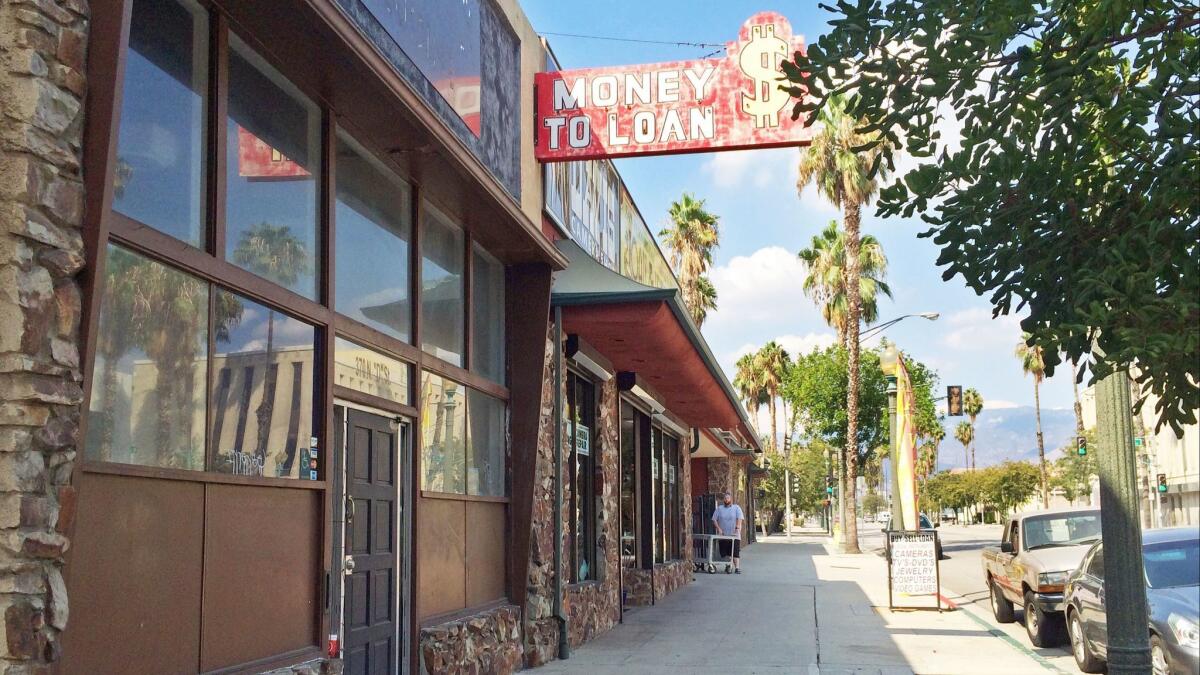Op-Ed: How California towns like San Bernardino get a bad reputation

- Share via
Remember Soarin’ Over California? It was a cheesy flight simulator at Disney’s California Adventure that took riders above the Mouse’s version of the Golden State. Napa’s wineries, Half Dome’s majesty, Camarillo’s … whatever, Soarin’ was California boosterism at its most blatant. The attraction even occasionally blasted quintessential state scents like orange blossoms and ocean mist to further the dream.
I rode it once with a friend, about a decade ago, and enjoyed it. But we agreed that Soarin’ Over California didn’t go far enough. “What about Soarin’ Over Bakersfield?” she cracked.
“Soarin’ Over Stockton,” I replied.
And we went back and forth, naming cities and regions that the Californian psyche associates with blight and bad vibes. El Centro. Fresno. Richmond. Menifee. The Salton Sea. Cowschwitz, off Interstate 5. Hemet. We hadn’t visited most of the areas we named at the time, but we knew enough about their reputations to use them as a punchline — Soarin’ Over Salinas! — again and again.
Disney rebranded Soarin’ Over California as Soarin’ Around the World in 2016, in the company’s eternal attempt to salvage its lesser Anaheim theme park. But I thought about it recently when friends in San Bernardino sent me a viral video that bashed their hometown.
A college student from the city had brought her roommate home for a visit over winter break. They drove down Base Line Street, one of San Berdoo’s main thoroughfares and one that has seen better days. “Within 30 seconds of driving down Baseline,” the student wrote on Twitter, “we saw 5 prostitutes & 10+ crackheads. To me it was normal, to her it was a whole new world.”
Accompanying the tweet was a video (viewed more than 150,000 times) of the girls laughing about what they saw. The student defended her mockery in a subsequent tweet, telling haters, “do y’all even live in San Bernardino? Cuz if you do, tell me you’ve never laughed at the crazy [stuff] you see down here!!”
San Bernardino — yes, even San Bernardino — has a lot to offer. And it’s worth publicizing that fact.
Locals know the good and the bad where they live and so can love and hate with authority; they’ve earned the right to criticize themselves. But the problem with trash-talking California’s hard-times cities is that the negative too often becomes the dominant narrative.
And — here’s my theory — the decline of local news exacerbates the problem.
Community papers and websites are the plankton in the media ecosystem; regional outlets frequently pick up their stuff because they are too lazy or distant to do any original coverage. In turn, even bigger national outlets swoop in to amplify a story. Because local publications often care about highlighting the positive in their towns, this gradual food chain improves the public perceptions of a place. But remove those small-fry chroniclers, and none of the bigger fish bother with the good — and then it becomes all about the bad. Prostitutes. Crackheads. Maybe throw in a few crazy murders.
(Think about that when you read about all the headaches plaguing Southern California newspapers — layoffs, clueless new leadership or outright shutdowns.)
In 2015, for example, this paper ran a multipart series titled “San Bernardino: Broken City,” which happened to publish the same month as the terror attack where 14 people were killed. I wrote a personal letter to The Times’ then-editor that pointed out the package was little more than ghetto porn that did nothing to uplift the lives of residents.
But San Bernardino — yes, even San Bernardino — has a lot to offer. And it’s worth publicizing that fact.
In my 2012 book, “Taco USA: How Mexican Food Conquered America,” I told the story of San Bernardino’s Mitla Café, the oldest Mexican restaurant in the Inland Empire. Its delicious hard-shell tacos, served from a historic diner off Route 66, were the inspiration for Glenn Bell to create Taco Bell. After the book’s release, papers from the San Bernardino Sun to the New York Times retold Mitla’s story, which drew more customers.
The good press continues to pay off. A couple of years ago, Mitla’s current management — in its fourth generation of the same family — opened a long-shuttered banquet hall they now use for comedy nights and Sunday brunches. They soon will appear in a Netflix special, which will bring even more business, which will allow Mitla to remain in San Bernardino’s West Side, hard-hit during the Great Recession but slowly coming back.
Places like La Jolla and Elk Grove don’t need more love. In 2018, let’s turn our attention and dollars to spots like San Ysidro and Tracy. Find the businesses and activists who fight for their neighborhoods. Swoop in not only to drop some cash into local coffers but to further anchor our collective California identity.
Or let the city without sin cast the first stone. Some of our wealthier ’burbs have problems more serious than San Bernardino’s. Disturbingly high concentrations of anti-vaxxers live in wealthy South Orange County; the Bel-Air fires started thanks to a homeless encampment near the enclaves. Prostitutes and crackheads? Sounds like a pre-#MeToo Hollywood party to me — and those folks are all rich, rich, rich.
Follow the Opinion section on Twitter @latimesopinion or Facebook
Twitter: @gustavoArellano
More to Read
A cure for the common opinion
Get thought-provoking perspectives with our weekly newsletter.
You may occasionally receive promotional content from the Los Angeles Times.







